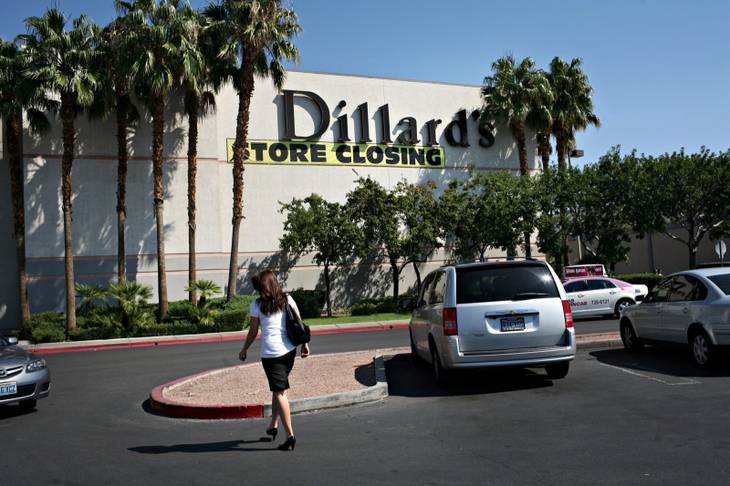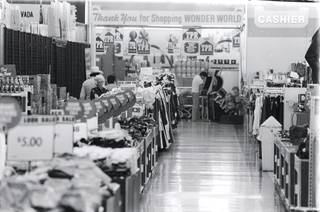Suburban sprawl is a way of life in Las Vegas, and the valley's shopping centers tell an important story about the growth away from the inner core. A look at where we buy our food and clothes shows which areas are hot spots for development and which neighborhoods have been left to decay.
Through the ’60s, locals flocked to Fremont Street to frequent clothing shops, pharmacies and grocery stores.
They fanned out in the ’70s and ’80s, choosing Maryland Parkway, south of downtown, as a top retail corridor. The intersection of Sahara Avenue and Decatur Boulevard, southwest of downtown, became a magnet for big-name stores.
By the late ’90s, with the 215 Beltway in the works, homebuilders fanned out in all directions to create developments, taking retailers and shoppers with them to new suburbs.
What’s left today are two worlds of Las Vegas retail: massive, thriving shopping hubs with brand-name stores on the outer rings of the valley, and small, low-end strip malls with mom-and-pop stores and lots of vacancies in the inner core.
“It has just been a push to the Beltway,” said Kyle Nagy, a director with CommCap Advisors, a commercial mortgage brokerage firm. "That’s where the homes were being built, and retail follows rooftops."
With Las Vegas recovering from the recession, retail construction is largely at a standstill these days — with one glaring exception.
Howard Hughes Corp., the developer of the Summerlin master-planned community, is building the Shops at Summerlin, a 1.6 million-square-foot shopping and office complex off the 215 Beltway near Red Rock Resort. The project, mothballed in 2008 by former owners and resurrected last September, is expected to open in fall 2014.
It is a prime example of Las Vegas’ sprawl. The complex is about 12 miles from downtown, near the western edge of the valley.
RAFI Architecture principal Robert Fielden remembers when downtown was the place to shop. He moved to the valley in 1963 and recalls Fremont Street being a traditional, small-town commercial district. Local residents walked there to buy groceries, clothing and other goods.
But downtown also had a cluster of casinos, and the retail space got gobbled up by the expanding gambling industry.
In the ‘70s, Maryland Parkway became the valley’s premier shopping area, thanks in large part to Boulevard mall, which opened in the '60s. The mall was hugely popular, and the owners expanded it several times.
But it eventually lost its standing with shoppers, as they fled for the suburbs and Fashion Show mall, which opened in 1981.
Today, Fashion Show is filled with department and specialty stores and is popular with tourists and locals alike. Boulevard mall is a second-tier mall riddled with financial problems. In late July, a month after lenders took control of the center, brokers sent out a marketing brochure to try to sell it. The listed price: “best offer.”
Many locals also shopped in the ’70s at Wonder World, a department store chain that sold clothing, electronics, groceries and more.
“It had everything you could need,” said Prudential Americana Group broker Jack Woodcock, who moved to Las Vegas in 1971.
Woodcock recalled three or four Wonder World locations in the valley, including one on Decatur Boulevard at Vegas Drive in what’s now a dicey neighborhood. Today that intersection is close to a low-end strip mall that houses a Family Dollar, Habitat for Humanity used-goods store, hair salon, cellphone store and beauty supply shop.
Retail continued to spread in the ’80s and ’90s as Las Vegas grew rapidly. Popular shopping spots included Commercial Center, a retail plaza on Sahara Avenue east of the Strip, and the intersection of Sahara Avenue and Decatur Boulevard. Today, both stand out for their oversized, empty parking lots and thin shopping selection.
The drain of business from the inner core soon turned into a flood when construction on the 215 Beltway began.
Neighborhoods and retail centers sprouted near freeway interchanges. During the boom years, from 2004 to 2007, construction reached frantic proportions, with strip malls, office buildings and subdivisions popping up on a seemingly daily basis near the interstate.
“You couldn’t build fast enough,” Nagy said.
Developer Terri Sturm capitalized on and helped fuel the boom, building massive shopping centers around the valley. She sold six in December for almost $300 million.
Like other developers, Sturm focused on freeway interchanges. One of her projects, the 650,000-square-foot Eastern Beltway Center at Eastern Avenue and the 215 Beltway, opened in the late 1990s, around the same time the freeway debuted. Since then, Eastern Avenue has become one of the most densely populated retail corridors in the valley, filled with strip malls, big-box stores and restaurants.
The Eastern Beltway Center is almost fully occupied today. Even during the recession, its occupancy rate never dropped below 95 percent, Sturm said.
When it opened, the area was sparsely populated. There wasn’t a single house south of St. Rose Parkway, an area that’s now almost fully developed.
“That was solid dirt out there,” Sturm said.

